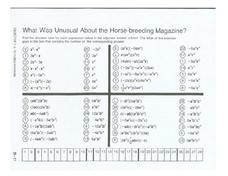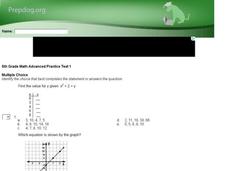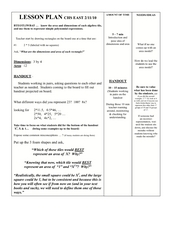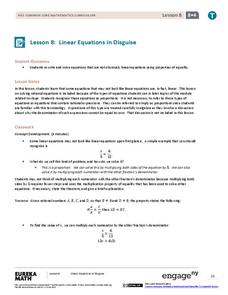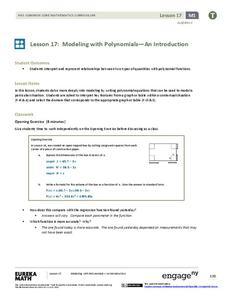Curated OER
Algebra- Cell Phone Plans
High schoolers analyze graphs to compare cell phone plans. In this algebra lesson, students work together to analyze phone plans and report the best phone plan. High schoolers develop tables and graphs.
Curated OER
Simplest Form
In this simplest form learning exercise, 9th graders solve and complete 28 different problems that include solving a puzzle. First, they determine the simplest for each expression given in the adjacent answer column. Then, students write...
Curated OER
Grade 5 Math-Advanced 1
In this grade 5 math worksheet, 5th graders answer a set of 18 "advanced" multiple choice questions. Answers may be submitted and checked on-line.
Curated OER
Undefined Algebraic Fraction
In this algebraic fractions worksheet, 9th graders solve 10 different problems that include various undefined algebraic fractions. They determine the value for each variable that makes the fraction undefined in each situation. Then,...
Curated OER
Algebraic Equations
In this algebraic equations worksheet, students solve and check ten algebraic equations. In the first 3 problems, they find the solution of the equation by using the substitution method. And in the last 7, students solve for each...
Curated OER
Basic Algebra
In this basic algebra worksheet, students solve each of 20 equations by following the rules for basic algebra. They identify the variable in each equation. Then, students add or subtract like terms to get them on one side and the...
Curated OER
Area and dimensions
Sixth graders study the concepts of area and dimensions. In this area and dimensions lesson plan, 6th graders work in pairs to complete the handout included that illustrates ways to represent various numbers. Students also determine what...
Curated OER
Algebra Word Problems
In this inequality word problem worksheet, students solve ten word problems related to algebra and inequalities. They first determine how many pounds of cheese it would take to make a specific amount of grated cheese topping. Students...
EngageNY
Comparing Methods—Long Division, Again?
Remember long division from fifth grade? Use the same algorithm to divide polynomials. Learners develop a strategy for dividing polynomials using what they remember from dividing whole numbers.
EngageNY
Relationships Between Quantities and Reasoning with Equations and Their Graphs
Graphing all kinds of situations in one and two variables is the focus of this detailed unit of daily lessons, teaching notes, and assessments. Learners start with piece-wise functions and work their way through setting up and solving...
EngageNY
Graphing Quadratic Functions from Factored Form
How do you graph a quadratic function efficiently? Explore graphing quadratic functions by writing in intercept form with a lesson that makes a strong connection to the symmetry of the graph and its key features before individuals write...
EngageNY
Linear Equations in Disguise
In the eighth segment of a 33-part unit, learners look at equations that do not appear to be linear at first glance. The equations are proportions where the numerators and denominators may have more than one term. To round out the...
EngageNY
Modeling from a Sequence
Building upon previous knowledge of sequences, collaborative pairs analyze sequences to determine the type and to make predictions of future terms. The exercises build through arithmetic and geometric sequences before introducing...
EngageNY
Solving Basic One-Variable Quadratic Equations
Help pupils to determine whether using square roots is the method of choice when solving quadratic equations by presenting a lesson that begins with a dropped object example and asks for a solution. This introduction to solving by square...
EngageNY
Modeling with Exponential Functions
These aren't models made of clay. Young mathematicians model given population data using exponential functions. They consider different models and choose the best one.
Inside Mathematics
Squares and Circles
It's all about lines when going around. Pupils graph the relationship between the length of a side of a square and its perimeter. Class members explain the origin in context of the side length and perimeter. They compare the graph to the...
Curated OER
Exponent Law
In this algebra worksheet, problems containing exponents are solved by applying the properties of exponents. There are 10 questions with an answer key.
Curated OER
Famous Public Properties
What can a middle schooler do in 90 minutes? He can practice using the commutative, associative and distributive properties of addition and multiplication. He can also simplify expressions using the commutative, associative and...
EngageNY
The Multiplication of Polynomials
If you can multiply multi-digit integers, you can multiply polynomials. Learners use an area model to compare multiplying numbers to multiplying polynomials. They progress to using the distributive property.
West Contra Costa Unified School District
Evaluating Functions
Functions as inputs for other functions? After reviewing function notation and how to input values to evaluate functions, class members input functions into functions, essentially determining the composition of functions.
EngageNY
Simplifying Square Roots
Explore the process of simplifying square roots through an analysis of perfect squares. The fourth lesson of 25 expects individuals to find the perfect square factors in each radicand as a means of simplifying. The perfect square factor...
Curated OER
Polynomials and Linear Factors
This algebra activity reviews writing polynomials in standard form from factored form, looks at the graphs of polynomials of degree higher than two, and identifies the zeros of polynomials using the Factor Theorem and Fundamental Theorem...
EngageNY
Modeling with Polynomials—An Introduction (part 2)
Linear, quadratic, and now cubic functions can model real-life patterns. High schoolers create cubic regression equations to model different scenarios. They then use the regression equations to make predictions.
EngageNY
Bean Counting
Why do I have to do bean counting if I'm not going to become an accountant? The 24th installment of a 35-part module has the class conducting experiments using beans to collect data. Learners use exponential functions to model this...



